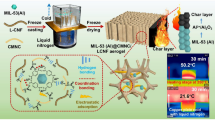Abstract
The aqueous counter collision (ACC) method can provide single bacterial nanocellulose ribbons (ACC-BNC) in a desired width, from a pellicle produced by Gluconacetobacter xylinus. Kose et al. (Biomacromolecules, 12:716–720, 2011) reported that the ACC process transformed the major Iα crystalline phase of the native fiber to a stable Iβ phase, without decreasing the overall crystallinity. The current study investigated the variation of the crystalline phases of ACC-BNC, upon interaction with poly(vinyl alcohol) (PVA). ACC-BNC of desired width was mixed with PVA, without any chemical reaction occurring. This resulted in a homogeneous suspension. The equilibrium melting point of PVA in cast nanocomposite films was investigated, as a probe for evaluating the crystalline surface properties of the ACC-BNC. A decrease in the equilibrium melting point of PVA would have indicated attractive interactions between the PVA and ACC-BNC. However, the nature of the ACC-BNC surface in the presence of PVA depended on the ACC-BNC width. Thicker ACC-BNC acted as a nucleating agent for PVA. Thinner ACC-BNC acted as a diluent of PVA. This tendency was opposite to the case for Iβ-dominant ACC-wood nanocellulose. ACC-BNC acting as a nucleating agent was more efficient than ACC-wood nanocellulose. The results suggested that ACC-BNC surfaces, which probably contained I α phases, had different characteristics to those of Iβ-dominant ACC-wood nanocellulose surfaces.




Similar content being viewed by others
References
Atalla RH, Vanderhart DL (1984) Native cellulose: a composite of two distinct crystalline forms. Science 223(4633):283–285
Flory PJ (1953) Principles of polymer chemistry. Cornell University Press, Ithaca, pp 568–571
Helenius G, Backdahl H, Bodin A, Nannmark U, Gatenholm P, Risberg B (2006) In vivo biocompatibility of bacterial cellulose. J Biomed Mat Res Part A 76A(2):431–438
Hestrin S, Schramm M (1954) Synthesis of cellulose by Acetobacter xylinum.2. Preparation of freeze-dried cells capable of polymerizing glucose to cellulose. Biochem J 58(2):345–352
Hoffman JD, Weeks JJ (1962) Melting process and equilibrium melting temperature of polychlorotrifuluoroethylene. J Res Natl Bur Stand Sect A Phys Chem 66(JAN-F):13–28
Huang Y, Zhu C, Yang J, Nie Y, Chen C, Sun D (2014) Recent advances in bacterial cellulose. Cellulose 21(1):1–30
Ifuku S, Nogi M, Abe K, Handa K, Nakatsubo F, Yano H (2007) Surface modification of bacterial cellulose nanofibers for property enhancement of optically transparent composites: dependence on acetyl-group DS. Biomacromol 8(6):1973–1978
Imken RL, Paul DR, Barlow JW (1976) Transition behavior of poly(vinylidene fluoride)/poly(ethyl methacrylate) blends. Polym Eng Sci 16(9):593–601
Jorfi M, Foster EJ (2015) Recent advances in nanocellulose for biomedical applications. J Appl Polym Sci 132(14):41719
Klemm D, Kramer F, Moritz S, Lindstrom T, Ankerfors M, Gray D, Dorris A (2011) Nanocelluloses: a new family of nature-based materials. Angew Chemi Int Ed 50(24):5438–5466
Kondo T, Kasai W (2014) Autonomous bottom-up fabrication of three-dimensional nano/microcellulose honeycomb structures, directed by bacterial nanobuilder. J Biosci Bioeng 118(4):482–487
Kondo T, Sawatari C, Manley RS, Gray DG (1994) Characterization of hydrogen bonding in cellulose-synthetic polymer blend systems with regioselectively substituted methylcellulose. Macromolecules 27(1):210–215
Kondo T, Nojiri M, Hishikawa Y, Togawa E, Romanovicz D, Brown RM (2002) Biodirected epitaxial nanodeposition of polymers on oriented macromolecular templates. PANS 99(22):14008–14013
Kondo T, Kasai W, Nojiri M, Hishikawa Y, Togawa E, Romanovicz D, Brown RM (2012) Regulated patterns of bacterial movements based on their secreted cellulose nanofibers interacting interfacially with ordered chitin templates. J Biosci Bioeng 114(1):113–120
Kondo T, Kose R, Naito H, Kasai W (2014) Aqueous counter collision using paired water jets as a novel means of preparing bio-nanofibers. Carbohydr Polym 112:284–290
Kose R, Kondo T (2013) Size effects of cellulose nanofibers for enhancing the crystallization of poly(lactic acid). J Appl Polym Sci 128(2):1200–1205
Kose R, Mitani I, Kasai W, Kondo T (2011) “Nanocellulose” as a single nanofiber prepared from pellicle secreted by gluconacetobacter xylinus using aqueous counter collision. Biomacromol 12(3):716–720
Moon RJ, Martini A, Nairn J, Simonsen J, Youngblood J (2011) Cellulose nanomaterials review: structure, properties and nanocomposites. Chem Soc Rev 40(7):3941–3994
Nishio Y, Haratani T, Takahashi T (1989) Cellulose/poly(vinyl alcohol) blends: an estimation of thermodynamic polymer-polymer interaction by melting point depression analysis. Macromolecules 22(5):2547–2549
Sawatari C, Kondo T (1999) Interchain hydrogen bonds in blend films of poly(vinyl alcohol) and its derivatives with poly(ethylene oxide). Macromolecules 32(6):1949–1955
Scott RL (1949) The thermodynamics of high polymer solutions. V. Phase equilibria in the ternary system: polymer 1—polymer 2—solvent. J Chem Phys 17(3):279–284
Shah N, Ul-Islam M, Khattak WA, Park JK (2013) Overview of bacterial cellulose composites: a multipurpose advanced material. Carbohydr Polym 98(2):1585–1598
Tsuboi K, Yokota S, Kondo T (2014) Difference between bamboo- and wood-derived cellulose nanofibers prepared by the aqueous counter collision method. Nord Pulp Res J 29(1):69–76
Urushihara T, Okada K, Watanabe K, Toda A, Kawamoto N, Hikosaka M (2009) Acceleration mechanism in critical nucleation of polymers by epitaxy of nucleating agent. Polym J 41(3):228–236
Vitta S, Thiruvengadam V (2012) Multifunctional bacterial cellulose and nanoparticle-embedded composites. Cur Sci 102(10):1398–1405
Wada M, Okano T, Sugiyama J (1997) Synchrotron-radiated X-ray and neutron diffraction study of native cellulose. Cellulose 4(3):221–232
Yamamoto H, Horii F, Hirai A (1996) In situ crystallization of bacterial cellulose. 2. Influences of different polymeric additives on the formation of celluloses I-alpha and I-beta at the early stage of incubation. Cellulose 3(4):229–242
Yamanaka S, Watanabe K, Kitamura N, Iguchi M, Mitsuhashi S, Nishi Y, Uryu M (1989) The structure and mechanical properties of sheets prepared from bacterial cellulose. J Mat Sci 24(9):3141–3145
Yano H, Sugiyama J, Nakagaito AN, Nogi M, Matsuura T, Hikita M, Handa K (2005) Optically transparent composites reinforced with networks of bacterial nanofibers. Adv Mater 17(2):153–155
Author information
Authors and Affiliations
Corresponding author
Rights and permissions
About this article
Cite this article
Ishikawa, G., Kondo, T. Thermodynamic effect on interaction between crystalline phases in size-controlled ACC-bacterial nanocellulose and poly(vinyl alcohol). Cellulose 24, 5495–5503 (2017). https://doi.org/10.1007/s10570-017-1532-2
Received:
Accepted:
Published:
Issue Date:
DOI: https://doi.org/10.1007/s10570-017-1532-2




